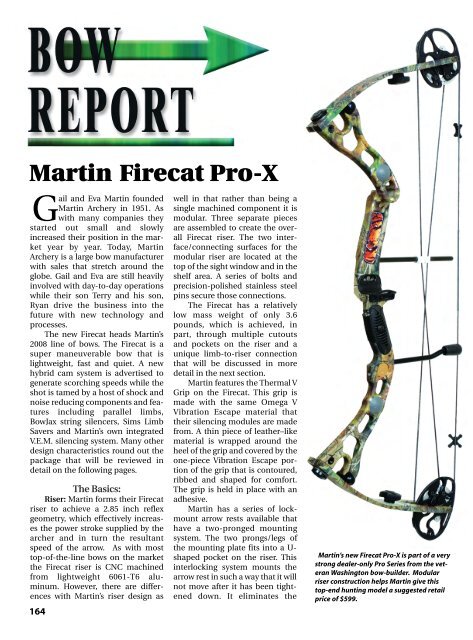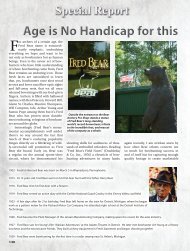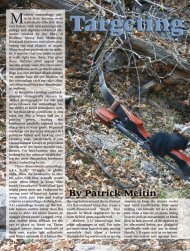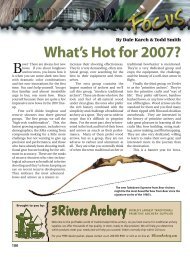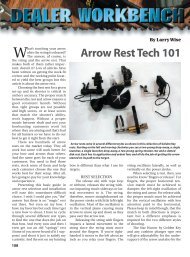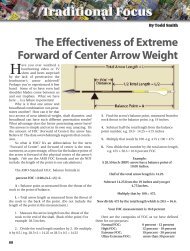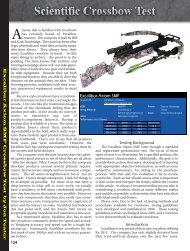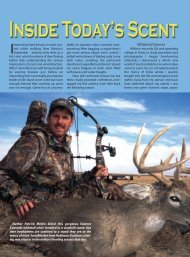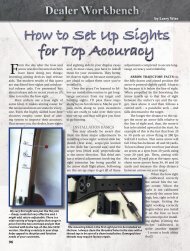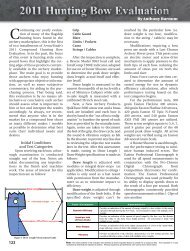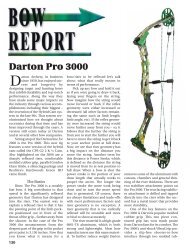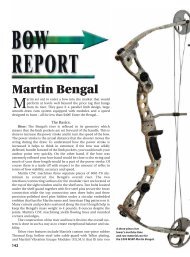Martin Firecat Pro-X - Arrow Trade Magazine!
Martin Firecat Pro-X - Arrow Trade Magazine!
Martin Firecat Pro-X - Arrow Trade Magazine!
You also want an ePaper? Increase the reach of your titles
YUMPU automatically turns print PDFs into web optimized ePapers that Google loves.
<strong>Martin</strong> <strong>Firecat</strong> <strong>Pro</strong>-X<br />
Gail and Eva <strong>Martin</strong> founded<br />
<strong>Martin</strong> Archery in 1951. As<br />
with many companies they<br />
started out small and slowly<br />
increased their position in the market<br />
year by year. Today, <strong>Martin</strong><br />
Archery is a large bow manufacturer<br />
with sales that stretch around the<br />
globe. Gail and Eva are still heavily<br />
involved with day-to-day operations<br />
while their son Terry and his son,<br />
Ryan drive the business into the<br />
future with new technology and<br />
processes.<br />
The new <strong>Firecat</strong> heads <strong>Martin</strong>’s<br />
2008 line of bows. The <strong>Firecat</strong> is a<br />
super maneuverable bow that is<br />
lightweight, fast and quiet. A new<br />
hybrid cam system is advertised to<br />
generate scorching speeds while the<br />
shot is tamed by a host of shock and<br />
noise reducing components and features<br />
including parallel limbs,<br />
BowJax string silencers, Sims Limb<br />
Savers and <strong>Martin</strong>’s own integrated<br />
V.E.M. silencing system. Many other<br />
design characteristics round out the<br />
package that will be reviewed in<br />
detail on the following pages.<br />
The Basics:<br />
Riser: <strong>Martin</strong> forms their <strong>Firecat</strong><br />
riser to achieve a 2.85 inch reflex<br />
geometry, which effectively increases<br />
the power stroke supplied by the<br />
archer and in turn the resultant<br />
speed of the arrow. As with most<br />
top-of-the-line bows on the market<br />
the <strong>Firecat</strong> riser is CNC machined<br />
from lightweight 6061-T6 aluminum.<br />
However, there are differences<br />
with <strong>Martin</strong>’s riser design as<br />
164<br />
well in that rather than being a<br />
single machined component it is<br />
modular. Three separate pieces<br />
are assembled to create the overall<br />
<strong>Firecat</strong> riser. The two interface/connecting<br />
surfaces for the<br />
modular riser are located at the<br />
top of the sight window and in the<br />
shelf area. A series of bolts and<br />
precision-polished stainless steel<br />
pins secure those connections.<br />
The <strong>Firecat</strong> has a relatively<br />
low mass weight of only 3.6<br />
pounds, which is achieved, in<br />
part, through multiple cutouts<br />
and pockets on the riser and a<br />
unique limb-to-riser connection<br />
that will be discussed in more<br />
detail in the next section.<br />
<strong>Martin</strong> features the Thermal V<br />
Grip on the <strong>Firecat</strong>. This grip is<br />
made with the same Omega V<br />
Vibration Escape material that<br />
their silencing modules are made<br />
from. A thin piece of leather–like<br />
material is wrapped around the<br />
heel of the grip and covered by the<br />
one-piece Vibration Escape portion<br />
of the grip that is contoured,<br />
ribbed and shaped for comfort.<br />
The grip is held in place with an<br />
adhesive.<br />
<strong>Martin</strong> has a series of lockmount<br />
arrow rests available that<br />
have a two-pronged mounting<br />
system. The two prongs/legs of<br />
the mounting plate fits into a Ushaped<br />
pocket on the riser. This<br />
interlocking system mounts the<br />
arrow rest in such a way that it will<br />
not move after it has been tightened<br />
down. It eliminates the<br />
<strong>Martin</strong>’s new <strong>Firecat</strong> <strong>Pro</strong>-X is part of a very<br />
strong dealer-only <strong>Pro</strong> Series from the veteran<br />
Washington bow-builder. Modular<br />
riser construction helps <strong>Martin</strong> give this<br />
top-end hunting model a suggested retail<br />
price of $599.
The new Thermal V grip uses the same<br />
material <strong>Martin</strong> chose for its patented<br />
riser-mounted dampeners. The trim molded<br />
grip wraps the front and sides, while<br />
black leather is what your hand presses<br />
against at full draw.<br />
occasional arrow rest creep found<br />
with traditionally mounted rests. If<br />
you still desire to use a traditional<br />
mount rest you can do so and <strong>Martin</strong><br />
provides a plastic spacer that<br />
increases the rest mounting platform<br />
area.<br />
Also found on the <strong>Firecat</strong>’s riser<br />
is a straight, polished carbon cable<br />
rod, STS String Stopper, two<br />
Vibration Escape Modules (V.E.M.s),<br />
several company emblems and a<br />
shelf cover made of Omega V<br />
Vibration Escape material. The riser<br />
is film dip finished in New Realtree<br />
APG camo.<br />
Customer Connection: One of my<br />
favorite features on this riser is the<br />
Omega V Vibration Escape material<br />
shelf guard and cover. No more cutting<br />
small pieces of moleskin, felt or<br />
other materials to make sure that a<br />
fallen arrow doesn’t clang on the<br />
shelf, scaring game away. It is a small<br />
detail that lets you know that <strong>Martin</strong><br />
<strong>Martin</strong>’s new V.E.M. Silencing <strong>Arrow</strong> Shelf keeps<br />
dropped arrows from clanking against the riser. It<br />
also hides a transition where precision pins and<br />
bolts join riser sections. The second transition<br />
point is between the sight window and the upper<br />
riser section.<br />
is thinking of the hunter and customers<br />
will appreciate it.<br />
The grip is warm, soft and comfortable.<br />
Let your customers know<br />
that while all grips may feel good in<br />
their hands while standing in the<br />
shop that the <strong>Firecat</strong> grip will be one<br />
of the few that still feel good on a icy<br />
cold November morning.<br />
The many cutouts and pockets<br />
on the riser contribute an overall<br />
mass weight of only 3.6 pounds. This<br />
is important when you are frozen<br />
like a statue, bow arm extended, as<br />
the buck of a lifetime stares in your<br />
direction for five minutes. The low<br />
mass weight along with a 33 inch<br />
axle-to-axle length also adds to the<br />
bow’s maneuverability.<br />
The Realtree AP camo pattern<br />
looks great on the <strong>Firecat</strong>. The<br />
appearance of a bow may not always<br />
be a feature that we readily admit is<br />
important but we all know that it<br />
truly is.<br />
Limbs/limb pockets: <strong>Martin</strong><br />
<strong>Firecat</strong> limb pockets are almost non-<br />
existent at first glance. The limb<br />
pocket design is dubbed the Roto<br />
Limb Cup Pivoting Limb System and<br />
consists of a limb bolt, barrel nut,<br />
slotted aluminum rocker, stainless<br />
steel pin, slotted limb bolt riser entry<br />
point, and a semi-circular rocker<br />
cradle machined directly into the<br />
end of the riser. There is no traditional<br />
pocket that cradles the end of<br />
the limb so overall bow weight is<br />
reduced. The limb bolt passes<br />
through a slot in the limb, through a<br />
slot in the end of the riser and into<br />
the barrel nut. The barrel nut rotates<br />
when the limb bolt is adjusted for<br />
draw weight creating the pivot that<br />
the system is partly named for. The<br />
end of the riser forms a U-shape<br />
with one leg of the “U” housing the<br />
barrel nut and the other leg<br />
machined to cradle the rounded<br />
rocker. On the inside diameter of the<br />
rocker cradle on the riser there is a<br />
small hole drilled that holds a small<br />
stainless steel pin. The pin is seated<br />
in the hole so that it is partially<br />
exposed. The exposed section of the<br />
pin rides in a slot on the machined<br />
rocker, which is secured to the limb.<br />
With the rocker held in place on<br />
the limb and the pin riding in the<br />
rocker groove, lateral stability is<br />
achieved. The cradle/rocker and<br />
About The Author<br />
Jon E. Silks has a degree in Quality Engineering and works in the area of nondestructive<br />
testing technology. His entire career has centered around the testing<br />
and evaluation of products. Now 38, he’s been bowhunting since age 12. Silks<br />
started writing for magazines and websites seven years ago and since then has<br />
done more than 400 product reviews. Manufacturers who appreciate his thoroughness<br />
and frankness have often asked him to review products that are still in<br />
the development<br />
stage. Silk’s work has<br />
appeared on the web<br />
on Bowhunting.net<br />
and Bowsite.com and<br />
has been published in<br />
Petersen’s Bowhunting,<br />
Bowhunter, <strong>Arrow</strong><br />
Adventure, and Whitetail<br />
Fanatic, along with<br />
<strong>Arrow</strong><strong>Trade</strong>. Jon and<br />
Jennifer Silks have six<br />
children and live in<br />
Pennsylvania. Silks can<br />
be reached at jon@silksoutdoors.com.<br />
165
limb bolt/barrel nut interfaces create<br />
additional centerline stability.<br />
<strong>Martin</strong> equips the <strong>Firecat</strong> with<br />
their popular Coreflex laminated<br />
fiberglass limbs. Using temperature<br />
controlled high-pressure presses the<br />
three-part laminate limbs are constructed<br />
with a special aerospace<br />
grade adhesive. Tension and compression<br />
laminates around a fiberglass<br />
core produce a super durable,<br />
trouble free limb. Limbs measure 13<br />
inches and are straight (not recurve)<br />
and solid (not split) in configuration.<br />
The limbs, like the riser, are film<br />
dipped in Realtree’s APG camo pattern.<br />
Limbs are available in 50, 60,<br />
and 70 pound peak draw weights.<br />
Limbs are set to achieve a parallel<br />
position at full draw.<br />
Customer Connection: The lack<br />
of material needed for this pocket<br />
design is a major factor in the overall<br />
light mass weight.<br />
Although this limb-to-riser<br />
interface is everything a hardcore<br />
minimalist could ask for it still has<br />
the necessary features to maintain<br />
lateral and in-line stability.<br />
<strong>Martin</strong> goes to great lengths to<br />
make sure the <strong>Firecat</strong>’s limbs are<br />
both effective and durable. Point this<br />
out to the customer who may not be<br />
familiar with the processes necessary<br />
to achieve a quality limb.<br />
Eccentrics: Powering the <strong>Firecat</strong><br />
to impressive IBO speeds is <strong>Martin</strong>’s<br />
new Cat Hybrid Duo Cam system.<br />
These eccentrics are “chained”<br />
together so that they constantly<br />
equal one another in output and<br />
Lower eccentric<br />
166<br />
synchronization. The<br />
result is a cam system<br />
that is designed to<br />
eliminate all timing<br />
issues. Unlike many<br />
eccentric systems<br />
that anchor the cables<br />
to a static connector<br />
(yokes that are connected<br />
to the outside<br />
edge of the limbs near<br />
the axle ends for<br />
example) the <strong>Martin</strong><br />
chained design terminates<br />
each end of the<br />
cable on a post located<br />
on the cam. The<br />
second cable is equally<br />
opposite the first in<br />
its rout and termination.<br />
Another point is<br />
that the string is evenly<br />
distributed above<br />
and below the center<br />
point of the riser,<br />
which means any<br />
mechanical string<br />
seating or true stretch<br />
due to prolonged use<br />
and breakdown of the<br />
string is also more<br />
likely to be even. The<br />
initial mechanical<br />
self-adjusting experienced<br />
during the “break in” period is<br />
more of a timing factor on bows that<br />
have uneven string distribution as it<br />
relates to the center point of the<br />
riser.<br />
Cat Hybrid Duo Cams are fully<br />
machined using the same high qual-<br />
Upper eccentric<br />
View of the<br />
new <strong>Firecat</strong> at<br />
full draw<br />
shows how the<br />
limbs become<br />
parallel and<br />
then move<br />
away from<br />
each other at<br />
the shot, helping<br />
to give the<br />
bow smoothshootingcharacteristics.<br />
ity aluminum found in the riser –<br />
6061-T6. <strong>Martin</strong> believes that this<br />
bow component is too important to<br />
be manufactured through stamping,<br />
molding or casting. A specially<br />
designed track in the module feeds<br />
the cable toward the center of the<br />
cam, which works to control cam<br />
lean.<br />
The cams ride on <strong>Martin</strong>’s Speed<br />
Bearings and stainless steel axles<br />
that are heat treated and hardened.<br />
Each R32RS Speed Bearing is sealed<br />
to keep the ball chamber lubrication<br />
intact and prevent any contamination<br />
from the outside. The R32RS<br />
designation basically defines the<br />
bore, outside diameter, width and<br />
ball dimensions along with static<br />
and dynamic load ratings.<br />
Draw lengths are available from<br />
26 to 30 inches with two rotating<br />
modules that do not require a bow<br />
press to adjust. Simply back the two
Load in pounds<br />
75<br />
70<br />
65<br />
60<br />
55<br />
50<br />
45<br />
40<br />
35<br />
30<br />
25<br />
20<br />
15<br />
10<br />
5<br />
0<br />
0<br />
1<br />
2<br />
3<br />
4<br />
5<br />
6<br />
7<br />
8<br />
9<br />
10<br />
11<br />
12<br />
13<br />
14<br />
15<br />
16<br />
17<br />
18<br />
19<br />
20<br />
21<br />
22<br />
23<br />
24<br />
25<br />
26<br />
27<br />
28<br />
29<br />
30<br />
31<br />
module screws out, rotate to the<br />
desired position and reinsert the<br />
screws – simple. Just make sure that<br />
both modules are in the corresponding<br />
position. <strong>Martin</strong>’s standard draw<br />
module offers 26 to 29 inches and<br />
the long-draw module can be adjusted<br />
between 29.5 and 30 inches. Letoff<br />
is standard at 80 percent, however<br />
it is adjustable with the draw stop.<br />
When brought to full draw the<br />
adjustable stop provides a super<br />
solid wall.<br />
Cams are anodized in black<br />
while the modules are anodized in a<br />
contrasting gray.<br />
Customer Connection: A system<br />
that stays in time and requires little<br />
maintenance can be used as a selling<br />
point no matter who is buying.<br />
SPEED! As you already know<br />
speed is a seller. This bow exhibits<br />
some of the best arrow velocities you<br />
can find on the market – use it.<br />
Modular systems are good for<br />
you, the dealer, and good for your<br />
customer. Basically, just by stocking<br />
several sets of modules your customer<br />
can walk out of your shop in a<br />
relatively short amount of time with<br />
a bow that fits him/her perfectly – no<br />
waiting for you to switch cams or to<br />
order cams in.<br />
Silencing/Shock reducing features:<br />
<strong>Martin</strong> goes all out in the noise<br />
and shock-reducing arena. Already<br />
Draw in inches<br />
mentioned previously in this report,<br />
the shelf cover is made with the<br />
Omega V proprietary material, as is<br />
the majority of the grip material.<br />
Also located on the riser are two new<br />
V.E.M.s (Vibration Escape Modules)<br />
that are situated in round cutouts<br />
above the sight window and below<br />
the grip. The new modules are<br />
weighted with suspended steel stabilizers.<br />
<strong>Pro</strong>truding out the back of the<br />
riser is the official STS String Stopper<br />
designed to tame after-the-shot<br />
string movement and vibration. The<br />
strings are also outfitted with BowJax<br />
StringJax silencers and the limbs<br />
come with pre-installed Sims Limb<br />
Savers. A great impact on overall<br />
noise and vibration can be attributed<br />
to the parallel position of the<br />
limbs at full draw. Limbs set at parallel<br />
positions will act in equal and<br />
opposite directions at the shot,<br />
which effectively cancels out any<br />
leftover energy.<br />
Customer Connection:<br />
Archers love a quiet bow that<br />
doesn’t jolt their hand when shot -<br />
especially the bowhunters. Point out<br />
the many features that contribute to<br />
the reduction of noise and vibration.<br />
If they need more convincing let<br />
them shoot it.<br />
Strings/Cables: The <strong>Firecat</strong> is<br />
outfitted with strings and cables<br />
made with <strong>Martin</strong>’s Double Helix<br />
1950 string material<br />
manufactured by BCY.<br />
The proprietary BCY<br />
blend is advertised to<br />
have great strength and<br />
increase speed. The<br />
strings and cables are<br />
pre-stretched/mechanically<br />
seated before, during<br />
and after the serving<br />
material is applied. The<br />
string measures 54 inches<br />
in length and consists<br />
of 24 strands while the<br />
cables are 38.25 inches<br />
in length, also with 24<br />
strands.<br />
Customer Connection:<br />
Any bowstring<br />
material coming out of<br />
the highly respected<br />
BCY, Incorporated can be expected<br />
to perform well and endure countless<br />
shots. With all the new bowstring<br />
companies popping up you can<br />
assure your customer that the strings<br />
and cables on the <strong>Firecat</strong> come from<br />
Patton<br />
Archery<br />
MFG., INC.<br />
P.O. Box 161 • Norway,<br />
MI 49870<br />
(906) 563-5990 • Fax (906) 563-7344<br />
pattonarchery@uplogon.com<br />
Limb Cups<br />
Risers<br />
Limbs<br />
Cams<br />
Wheels<br />
Wood Grips<br />
We do it all!<br />
Circle 183 on Response Card<br />
167
one of the best in the industry:<br />
<strong>Martin</strong> has been building bowstrings<br />
since it was founded more than a<br />
half-century ago and at one time was<br />
one of the largest string suppliers to<br />
the industry.<br />
As a side note – the <strong>Firecat</strong><br />
strings, cams, etc can be worked on<br />
without the use of a bow press. The<br />
barrel nut has a window in it that<br />
allows you to see how far the limb<br />
bolt is backed out. I turned the bolts<br />
out until they were only showing a<br />
few threads in that window and was<br />
able to remove the cables from the<br />
cams and thereby take all the pressure<br />
off of the system/limbs.<br />
Testing<br />
Tests were conducted using the<br />
following equipment:<br />
Spot-Hogg Hooter Shooter portable<br />
shooting machine<br />
Easton <strong>Pro</strong>fessional Chronograph<br />
with an infrared lighting system<br />
Oehler M35 Chronograph<br />
Easton Digital Bow Scale<br />
Hanson Scale<br />
Apple Super <strong>Pro</strong> Bow Press<br />
Apple Bow Drawing machine<br />
NAP QuikTune 3000 <strong>Arrow</strong> Rest<br />
Release Aid<br />
Quality Test: As with all bow<br />
evaluations we do the first step is<br />
always a thorough check of the bow’s<br />
finish, machining and mechanical<br />
components. The test bow was a preproduction<br />
model that was not in<br />
the same state finish wise as a production<br />
model will be so I will not<br />
comment on the quality of the finish.<br />
The machining, however, was finalized<br />
and in its production state when<br />
• Serving that will not slip or<br />
separate<br />
• Consistent peep alignment<br />
• No Creep<br />
•An unparalleled commitment to<br />
quality and customer service!<br />
• One year limited warranty (541) 575-0818<br />
WINNERSCHOICESTRINGS.COM<br />
168<br />
Circle 227 on Response Card<br />
it arrived. There were<br />
no obvious machining<br />
flaws and the<br />
transition areas at<br />
the riser module<br />
interfaces were<br />
seamless. (See Tim<br />
Dehn’s cover story<br />
for more on the<br />
modular riser construction<br />
process.)<br />
Mechanically all<br />
moving components<br />
were in good order.<br />
Set up: We have<br />
decided that what is<br />
generally termed as<br />
the ‘IBO’ speed is<br />
more relevant today<br />
as most archers and<br />
bowhunters make<br />
comparisons based<br />
on that speed rather<br />
than that of the traditional AMO<br />
(now ATA) rating. For this reason we<br />
have compiled a new “<strong>Arrow</strong><strong>Trade</strong>”<br />
test standard, which includes a 30<br />
inch draw length, 70-pound draw<br />
weight shooting a 350-grain arrow -<br />
industry-accepted specs for IBO ratings.<br />
The draw length for each test<br />
bow will be set according to the<br />
requirements of ASTM F 1544-04<br />
and the draw weight will be set to 70<br />
pounds +/- 1 pound (the +/- 1 pound<br />
requirement is also an ASTM F 1544<br />
-04 requirement). Speeds will be<br />
measured using a correctly spined<br />
350-grain arrow. This weight comes<br />
from the IBO rule, which states that,<br />
“<strong>Arrow</strong>s must weigh at least 5 grains<br />
per pound of the bow’s maximum<br />
shooting weight…” As stated earlier<br />
CHAMPION SHOOTER DAVE COUSINS TRUSTS ONLY<br />
WINNER’S CHOICE CUSTOM BOWSTRINGS<br />
<strong>Martin</strong> <strong>Firecat</strong> <strong>Pro</strong>-X<br />
Draw weights: 50, 60 and 70 pound peak<br />
Draw Lengths: 26-30 inches - modular<br />
Axle-to-axle length: 33 inches advertised,<br />
32.375 inches measured<br />
Brace Height: 7” (advertised and measured)<br />
Mass Weight: 3.6 pounds<br />
Let-off option: 80 percent standard - adjustable<br />
Eccentrics: Cat Hybrid Duo Cam<br />
Tested speed: 328 fps tested, 335-345 fps<br />
advertised<br />
Available finish: Realtree APG<br />
Cables: Double Helix, 38.25”<br />
String: Double Helix, 54”<br />
Grip: Thermal V Grip<br />
Riser: CNC machined 6061-T6 aluminum - reflex<br />
Limb pockets: Pivoting – Roto Limb Cup<br />
Limbs: Solid, straight, laminated Coreflex<br />
Cable Guard: Offset, polished carbon<br />
Warranty: Lifetime on riser and eccentrics,<br />
limited lifetime on limbs<br />
MSRP: $599.00<br />
<strong>Arrow</strong> <strong>Trade</strong> bows will be tested at 70<br />
pounds so: using the IBO rule we<br />
would multiply 5 grains x 70 pounds<br />
= 350 grains. To summarize our new<br />
‘<strong>Arrow</strong> <strong>Trade</strong> Standard’:<br />
Bow weight: 70 pounds +/-1 pound<br />
Draw Length will be set to 30 inches<br />
ATA (defined by ASTM F 1544-04)<br />
<strong>Arrow</strong>s will be selected according to<br />
the formula set out in the IBO rules<br />
for minimum grains per pound (350<br />
grains)<br />
All arrow velocity ratings must be<br />
measured using a shooting machine<br />
with mechanical release (We will use<br />
the definition of a shooting machine<br />
found in ASTM F 1544-04)<br />
A minimum of five shots must be<br />
chronographed using an arrow as<br />
defined above. The five (or more)<br />
shots will then be averaged to obtain<br />
the final reading. All velocity values<br />
for a given arrow must fall within a<br />
range of 2 ft/sec (Taken from ASTM F<br />
1544-04).<br />
An appropriate chronograph with<br />
a minimum of two gates set no more<br />
than 48 inches apart will be used. The<br />
initial gate will be set at 36 inches<br />
from the front of the bow’s handle.<br />
It should be noted here that<br />
manufacturers generally maximize<br />
the potential of their rigs to obtain
the speed rating that they advertise.<br />
An example of this is the use of a<br />
“string nock” instead of a brass nock,<br />
which reduces the weight on the<br />
string. Another method of maximizing<br />
speed ratings is to test without<br />
any silencers, etc on the string. Any<br />
weight added to the string will typically<br />
slow the bow down. Keep that<br />
in mind as you review the speed<br />
velocities in <strong>Arrow</strong><strong>Trade</strong> bow<br />
reports.<br />
A single brass nock and<br />
QuikTune 3000 <strong>Arrow</strong> Rest were<br />
attached to the bow – nothing more.<br />
With the exception of these two<br />
items every bow is tested, as it would<br />
be shipped to the dealer or customer.<br />
In other words, if it has string<br />
silencers or other components preinstalled<br />
it is tested with them<br />
installed. While the ‘official’ velocity<br />
rating for our calculations will be<br />
taken with an arrow as defined<br />
above, we will also use two other test<br />
arrows as reference points. This will<br />
be done to bring a bracketed picture<br />
of the bow’s speed performance to<br />
the reader. Test arrows include a<br />
lightweight 350-grain CAE carbon<br />
arrow, a mid-weight 420-grain Radial<br />
X Weave arrow and a relatively heavy<br />
540-grain Easton XX78 Super Slam<br />
arrow. Before recording speeds with<br />
these arrows the test bow was first<br />
paper tuned with each. Most every<br />
bowhunter/archer will be able to<br />
extrapolate their approximate arrow<br />
speed in relation to similar set-up<br />
parameters and results presented<br />
from the three test arrows.<br />
Speed/Velocity Test<br />
Speed was measured with the<br />
two chronographs listed above –<br />
Easton’s model as the primary and<br />
the Oehler as a backup/verification<br />
unit. Following are the resulting<br />
speed ratings for each in feet per second<br />
(rounded to the nearest whole<br />
number):<br />
540-grain arrow<br />
265.3<br />
265.5<br />
265<br />
Circle 246 on Response Card<br />
265.5<br />
265<br />
265<br />
265.3<br />
Average: 265 fps<br />
420-grain arrow<br />
300<br />
300<br />
300.3<br />
299.7<br />
299.6<br />
300.4<br />
300.3<br />
Average: 300 fps<br />
350-grain arrow<br />
327.8<br />
327.8<br />
327.3<br />
327.8<br />
327.5<br />
327.3<br />
327.7<br />
Average: 328 fps<br />
Potential customers will generally<br />
make their bow purchase choice<br />
169
ased on several factors including the cost, speed, shot<br />
noise, shock/vibration level, grip and the draw cycle.<br />
In our testing for <strong>Arrow</strong><strong>Trade</strong> <strong>Magazine</strong> we try to give<br />
you a feel for how a bow performs in the “subjective”<br />
areas mentioned above. You can then focus on the bow’s<br />
notable subjective points when interacting with your<br />
customer. The term “subjective” can basically be translated<br />
into “opinion”. I will be giving my opinion of this<br />
bow’s performance in the following subjective categories:<br />
Shot noise<br />
Grip comfort and function<br />
Draw cycle “feel”<br />
Shock and vibration levels<br />
For the <strong>Firecat</strong> I have combined the 1st and last categories<br />
from above – shot noise and shock/vibration levels.<br />
<strong>Martin</strong>’s <strong>Firecat</strong> is an exceptionally quiet bow with<br />
minimal hand shock or vibration, especially considering<br />
the speed that it generates. The shot noise is on par with<br />
the quietest in the industry and the jump/kick is noticeable,<br />
however still minimal in my hand. Vibration or<br />
sometimes what is described as the buzzing feeling that<br />
can be felt when shooting some bows was barely perceptible<br />
in the <strong>Firecat</strong>. Overall I was happy with the noise,<br />
shock and vibration levels coming from this newest of<br />
<strong>Martin</strong> bows. It is not the quietest, shock free bow I have<br />
shot, however, it is definitely one of the front pack –<br />
again, especially considering the speed!<br />
170<br />
•Over Over 20 million hits per month.<br />
•Worlds Worlds largest archery website.<br />
•Sponsored Sponsored by over 50<br />
manufacturers.<br />
•Talk Talk to fellow archers, pros,<br />
and bowhunters worldwide.<br />
Get Answers Free at ArcheryTalk.com<br />
Message Board includes:<br />
•General Archery Discussion<br />
•Bowhunting Discussion<br />
•Manufacturer’s <strong>Pro</strong>duct<br />
Announcements<br />
•Traditional Archery<br />
•Live Chat @ archerychat.com<br />
Free Archery Articles<br />
Free Archery Reviews<br />
Free Classifieds<br />
Free Picture Galleries<br />
The most comprehensive archery<br />
history website on the internet<br />
includes hundreds of photos,<br />
articles, video and more.<br />
Comfort is the cornerstone of the <strong>Martin</strong> Thermal V<br />
Grip. It is soft and warm. Where it is needed to allow for<br />
a consistent grip position <strong>Martin</strong> uses a leather-like<br />
material on the heel of the grip. This allows the archer’s<br />
hand to automatically move into a repeatable position<br />
for consistent and accurate shooting. My only suggestion<br />
to <strong>Martin</strong> in regard to the grip would be to extend<br />
the chamfer found just above the grip, further up toward<br />
the shelf. The hard edge that is there now can be felt in<br />
the web of my hand between my forefinger and thumb.<br />
A draw force curve on page 143 shows the detail of<br />
the <strong>Firecat</strong>’s draw cycle obtained from my test work.<br />
Closing Comments:<br />
An all around good score is in order for the <strong>Martin</strong><br />
<strong>Firecat</strong>. It generates the speed desired by many archers<br />
while demonstrating solid performance in the subjective<br />
categories that matter to almost every archer and<br />
bowhunter. I thought the bow had exceptional balance<br />
and enjoyed the 3.6-pound mass weight.<br />
Test Bow Technical Info: (350-grain arrow/ 70 pound<br />
peak draw weight)<br />
Kinetic Energy: 83.63 foot-pounds (This is the energy<br />
that actually goes into propelling the arrow. Basically<br />
it is the energy that is left over from the stored energy<br />
after all of the bow system friction is accounted for.)<br />
Stored Energy: 100.77 Foot-pounds (When you draw<br />
the bow you supply power/energy<br />
into the limbs. The amount of energy<br />
that the limbs can hold is known as<br />
the stored energy.)<br />
Efficiency Rating: 83.0 percent<br />
(This is the amount of the stored<br />
archerytalk.com<br />
archeryhistory.com<br />
energy (in percent) that can be successfully<br />
transferred into propelling<br />
the arrow upon release. The bow<br />
design, including limbs, limb pockets,<br />
cam systems, and axle types play<br />
into the bow’s efficiency. An example<br />
would be a sealed ball bearing in the<br />
idler wheel verses a simple unsealed<br />
rod bearing. It takes more energy to<br />
rotate the unsealed rod bearing<br />
(more friction) verses the sealed ball<br />
bearing (less friction) so more of the<br />
bow’s potential energy is used. The<br />
end result is a lower efficiency rating<br />
because less stored energy is left over<br />
to propel the arrow.)<br />
SE/PF Ratio: 1.44 (This is the<br />
ratio of stored energy to peak force.<br />
In other words what return are you<br />
getting for the power you supply.)<br />
Measured Speed: 328 FPS (The<br />
bow is tweaked to an ATA draw length<br />
of 30 inches and set exactly to a 70<br />
pound draw weight with a 350 grain<br />
arrow.)


